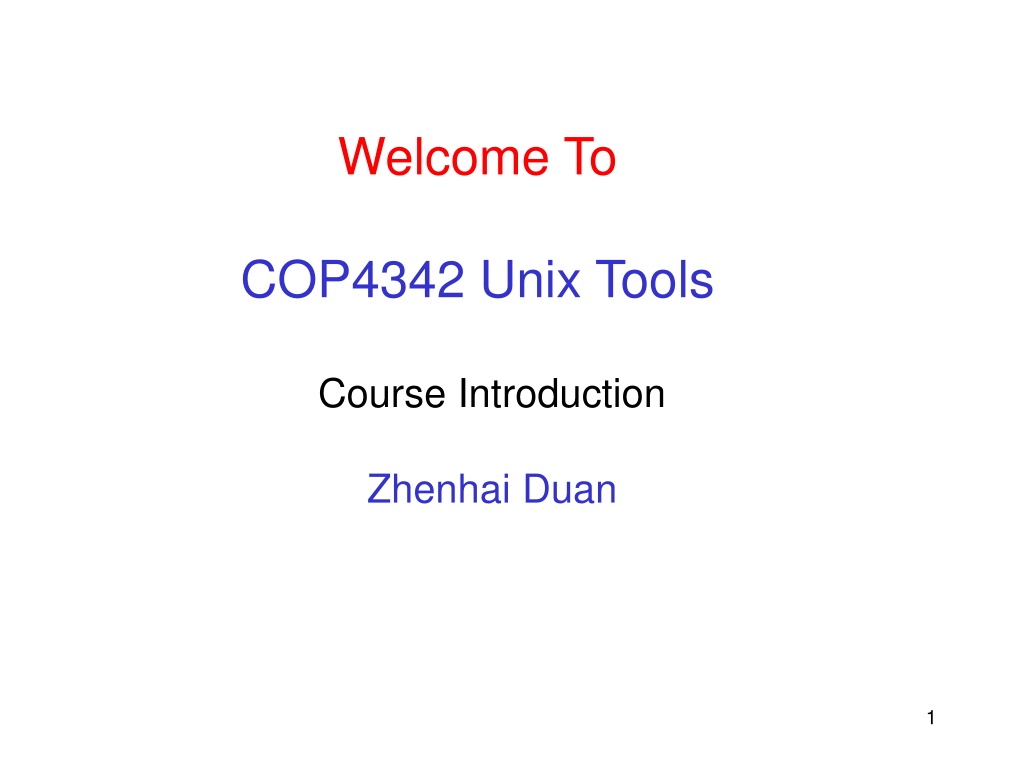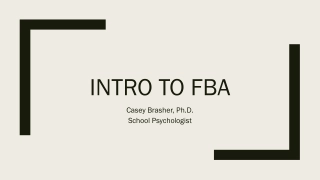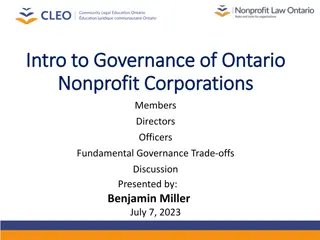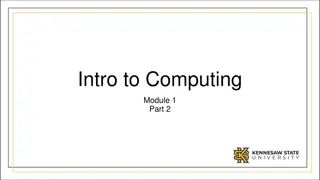
COP4342 Unix Tools Course Introduction by Professor Zhenhai Duan
Join Professor Zhenhai Duan in the COP4342 Unix Tools course where you will learn Unix shell programming, Perl programming, Python programming, Unix C/C++ programming, and other Unix tools like sed and awk. Explore course prerequisites, required materials, workload, and grading policies to excel in this interactive course.
Download Presentation

Please find below an Image/Link to download the presentation.
The content on the website is provided AS IS for your information and personal use only. It may not be sold, licensed, or shared on other websites without obtaining consent from the author. Download presentation by click this link. If you encounter any issues during the download, it is possible that the publisher has removed the file from their server.
E N D
Presentation Transcript
Welcome To COP4342 Unix Tools Course Introduction Zhenhai Duan 1
Instructor Professor Zhenhai Duan (duan@cs.fsu.edu) Office: 162 LOV Office hours: online via zoom 3:00PM to 4:00PM, T/Th Or by appointment if you want to meet at a different time Email: duan@cs.fsu.edu Class website: Use Canvas http://canvas.fsu.edu/ Research area Computer networks and security 2
TA TA Information TBA on Canvas 3
Objective of the Course At high level, we cover five areas of Unix utilities Unix shell programming Perl programming (to the intermediate level) Python programming (to the intermediate level) Unix C/C++ programming utilities such as make and debuggers Other Unix tools such as sed and awk We also study many Unix commands throughout the semester 4
Course Prerequisites Official prerequisite COP3330, which in turn requires COP3353 (Introduction to Unix) Basic requirements Working knowledge of Unix as a user Having taken at least one programming class Talk to me if you are not sure. Willing to learn and work hard Love to ask questions and solve problems 5
Course Materials Required textbook A practical guide to Linux Commands, Editors, and Shell Programming, 4th Edition, by Mark G. Sobell. Prentice Hall. Optional textbooks UNIX Power Tools Learning Perl Learning Python Programming Perl Unix in a Nutshell Linux Administration Handbook Class notes, other assigned readings and Materials on the Internet 6
Class Information Class website Canvas Announcement page Check regularly 7
Workload and Grading Policies Homework assignments: 55% Both written and programming assignments Will be announced on Canvas and in class. One midterm: 20% One final: 25% Final letter grades (link) 8
Important Dates Homework assignments Will be announced on Canvas and in class Midterm exam Final exam Link to important dates 9
Policies and Guidelines No late homework Start to work on homework assignments early and hand in on time 10% penalty if late no more than 24 hours 20% penalty if late no more than 48 hours 0 point if late more than 2 days No make-up exam, unless proof of emergency No Incomplete unless proof of emergency Scholastic behaviors You can study in group, but you must do your work independently Acknowledge reference/credits if receive help Academic Honor Code enforced 10
Accounts Computer Science account (<yourid>@cs.fsu.edu) For doing projects http://www.cs.fsu.edu/sysinfo/newstudent.html Use machines linprog.cs.fsu.edu to develop projects FSU account (Your FSUID) For receiving class announcements For submitting assignments For getting your grades https://www.ucs.fsu.edu/getStarted.html Access to Canvas For class materials, discussion board, grades etc. Through your FSU account http://canvas.fsu.edu/ 11
Tentative Schedule 1. Introduction to Unix (Brief) 2. Editors vi and emacs (brief) 3. Shell programming 4. Other (advanced) Unix utilities such AWK and SED 5. (C/C++) Programming utilities 6. Perl programming languge 7. Python programming language 12
Reading Assignment Chapters 1 and 2 14










